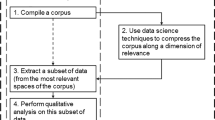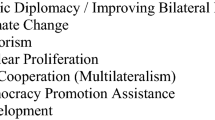Abstract
Virtual social networks have led to a new way of communication that is different from the oral one, where the restriction of time and space generates new linguistic practices. Twitter, a medium for political and social discussion, can be analyzed to understand new ways of communication and to explore sociosemiotics aspects that come with the use of the hashtags and their relationship with other elements. This paper presents a quantitative study of tweets, around a fixed hashtag, in relation with other contents that users bring to connection. By calculating the frequency of terms, a table of nodes and edges is created to visualize tweets like graphs. Our study applies social network analysis that, going beyond mere topology, reveals relevant sociosemantic communities providing insights for the comparison of social and political movements.









Similar content being viewed by others
References
Abascal-Mena R, López-Ornelas E, Zepeda-Hernández JS (2013) User generated content: an analysis of user behavior by mining political tweets. In: Ant Ozok A, Zaphiris P (eds) Online communities and social computing. Lecture Notes in Computer Science Volume 8029, Springer, Heidelberg, pp 3–12
Arquilla J, Ronfeldt D (2003) Networks and netwars: the future of terror, crime, and militancy. RAND, Santa Monica, p 380
Bastian M, Heymann S, Jacomy M (2009) Gephi: an open source software for exploring and manipulating networks. International AAAI conference on weblogs and social media
Bastos MT, Puschmann C, Travitzki R (2012) Tweeting political dissent: retweets as pamphlets in #FreeIran, #FreeVenezuela, #Jan25, #SpanishRevolution and #OccupyWallSt. Internet, politics, policy 2012: big data, big challenges? Oxford. Panel 6A: the Arab spring and political dissent, vol 2. Oxford Internet Institute, Oxford, pp 1–20
Bertrand KZ, Bialik M, Virdee K, Gros A, Bar-Yam Y (2013) Sentiment in New York City: a high resolution spatial and temporal view. arXiv:1308.5010
Brandes U (2001) A faster algorithm for betweenness centrality. J Math Sociol 25(2):163–177
Bruns A, Burgess JE (2011) The use of Twitter hashtags in the formation of ad hoc publics. 6th European Consortium for political research general conference, University of Iceland, Reykjavik
Castells M (2008) The new public sphere: Global civil society, communication networks, and global governance. Ann Am Acad Political Social Sci 616(1):78–93
Chew C, Eysenbach G (2010) Pandemics in the age of Twitter: content analysis of tweets during the 2009 H1N1 outbreak. PLoS One 5(11):e14118. doi:10.1371/journal.pone.0014118
Chung JE, Mustafaraj E (2011) Can collective sentiment expressed on Twitter predict political elections?. In: Burgard W, Roth D (eds) Proceedings of the 25th AAAI conference on artificial intelligence (AAAI 2011). AAAI Press, Menlo Park, pp 1768–1769
Conover M, Ratkiewicz J et al (2011) Political polarization on twitter. In: Proceedings 5th International AAAI conference on weblogs and social media (ICWSM)
Crismore A, Markannen R, Steffensen M (1993) Metadiscourse in persuasive writing: a study of texts written by American and Finnish University students. Writ Commun 10(1):39–71
Cunha E, Magno G, Comarela G, Almeida V, Gonçalves MA, Benevenuto F (2011) Analyzing the dynamic evolution of hashtags on twitter: a language-based approach. In: Proceedings of the workshop on language in social media (LSM 2011), pp 58–65
Cunha E, Magno G, Almeida V, Gonçalves MA, Benevenuto F (2012) A gender based study of tagging behavior in twitter. In: Proceedings of the 23rd ACM conference on hypertext and social media. ACM, pp 323–324
Dodds PS, Danforth CM (2010) Measuring the happiness of large-scale written expression: songs, blogs, and presidents. J Happiness Stud 11(4):441–456
Freeman LC (1979) Centrality in social networks: conceptual clarifications. Soc Netw 1(3):215–239
Georgakopoulou A (2013) Narrative analysis and computer-mediated communication. In: Herring S, Stein D, Virtanen T (eds) Pragmatics of computer-mediated communication. Mouton, Berlín, pp 695–715
Gitlin T (1980) The whole world is watching: mass media in the making and unmaking of the new left. University of California Press, Berkeley
Gruzd A, Doiron S, Mai P (2011) Is happiness contagious online? A case of Twitter and the 2010 Winter Olympics. In: Proceedings of the 44th Hawaii international conference on system sciences. IEEE Computer Society, Washington, DC
Habert B, Nazarenko A, Salem A (1997) Les linguistiques de corpus. Armand colin, Paris
Herrero R (2000) La terminología del análisis de redes: problemas de definición y de traducción. Política y sociedad 33:199–206
Heverin T, Zach L (2012) Use of microblogging for collective sense making during violent crises: a study of three campus shootings. J Am Soc Inform Sci Technol 63(1):34–47
Honeycutt C, Herring SC (2009) Beyond microblogging: conversation and collaboration via Twitter. 42nd Hawaii international conference on system sciences, Hawaii, pp 1–10
Hotho A, Nürnberger A, Paaß G (2005) A brief survey of text mining. Ldv Forum 20(1):19–62
Hyland K, Tse P (2004) Metadiscourse in academic writing. Appl Linguist 25(2):156–177
Kramer ADI (2010) An unobtrusive behavioral model of “Gross National Happiness”. In: Proceedings of CHI 2010. ACM Press, New York, pp 287–290
Kwak H, Lee C, Park H, Moon S (2010) What is Twitter, a social network or a news media? In: Proceedings of the 19th international conference on World Wide Web. ACM, pp 591–600
Lampos V, Lansdall-Welfare T, Araya R, Cristianini N (2013) Analysing mood patterns in the United Kingdom through Twitter content. arXiv preprint arXiv:1304.5507
Martínez V, González VM (2013) Sentiment characterization of an urban environment via Twitter. In: Urzaiz G, Ochoa SF, Bravo J, Chen LL, Oliveira J (eds) Ubiquitous computing and ambient intelligence. Context-awareness and context-driven interaction. Springer International Publishing, Cham, pp 394–397
Orihuela JL (2006) La revolución de los blogs. Cuando las bitácoras se convirtieron en el medio de comunicación de la gente. La Esfera de los Libros, Madrid, 20fbb06, ISBN: 84-9734-498-7, p 283
Peirce CS (1931) Collected writings (8 Vols.). Ed. Charles Hartshorne, Paul Weiss & Arthur W Burks. Harvard University Press, Cambridge
Poell T, de Kloet J, Zeng G (2014) Will the real Weibo please stand up? Chinese online contention and actor-network theory. Chin J Commun 7(1):1–18
Rodrigues BGA, Silva IS, Zaki M, Meira Jr W, Prates RO, Veloso A (2012) Characterizing the effectiveness of twitter hashtags to detect and track online population sentiment. In: CHI'12 Extended Abstracts on Human Factors in Computing Systems, ACM, pp 2621–2626
Romero D, Meeder B, Kleinberg J (2011) Differences in the mechanics of information diffusion across topics: idioms, political hashtags, and complex contagion on Twitter. International world wide web conference (WWW 2011). Hyderabad, India
Russell A (2011) The Arab spring extra-national information flows, social media and the 2011 Egyptian uprising. Int J Commun 5:10
Singh MP (2000) A social semantics for agent communication languages. In: Dignum F, Chaib-draa B, Weigand H (eds) Issues in agent communication. Proceedings of the IJCAI-99 Workshop on Agent Communication Languages, Springer, Berlin, pp 31–45
Wijaya V, Erwin A, Galinium M, Muliady W (2013) Automatic mood classification of Indonesian tweets using linguistic approach. 2013 international conference on information technology and electrical engineering (ICITEE), IEEE, pp 41–46
Zappavigna M (2011) Ambient affiliation: a linguistic perspective on Twitter. New Media Soc 13(5):788–806
Author information
Authors and Affiliations
Corresponding author
Appendix
Appendix
In this appendix is shown in detail the percentage of words obtained daily by each community. For example, for December 11 we have 20 communities where from the total number of concepts extracted for this day we got that the smallest community has 0.27 % of concepts while the biggest has 15.85 %.
Dec 6 | Dec 10 | Dec 11 | Dec 12 | Dec 13 | Dec16 |
|---|---|---|---|---|---|
0.22 | 0.6 | 0.27 | 0.45 | 0.34 | 1.34 |
0.44 | 0.6 | 0.82 | 0.45 | 0.68 | 3.36 |
0.66 | 2.99 | 0.82 | 0.45 | 1.71 | 4.03 |
1.31 | 2.99 | 1.09 | 0.45 | 2.05 | 4.7 |
2.62 | 2.99 | 1.09 | 0.9 | 2.4 | 4.7 |
4.15 | 3.59 | 1.64 | 0.9 | 3.08 | 6.71 |
4.15 | 4.19 | 2.19 | 1.8 | 4.79 | 8.05 |
4.8 | 4.79 | 2.46 | 2.25 | 4.79 | 8.05 |
5.02 | 7.78 | 3.28 | 2.25 | 5.48 | 10.07 |
5.02 | 9.58 | 3.83 | 3.15 | 5.48 | 11.41 |
5.24 | 9.58 | 4.1 | 5.41 | 5.48 | 12.75 |
5.46 | 10.18 | 4.64 | 6.76 | 6.51 | 24.83 |
6.11 | 11.98 | 6.28 | 6.76 | 6.51 | |
8.52 | 13.77 | 6.83 | 7.21 | 7.19 | |
9.39 | 14.37 | 7.38 | 7.66 | 7.19 | |
9.61 | 8.2 | 7.66 | 8.9 | ||
11.79 | 8.74 | 9.46 | 10.27 | ||
15.5 | 8.74 | 11.26 | 17.12 | ||
11.75 | 11.71 | ||||
15.85 | 13.06 |
Rights and permissions
About this article
Cite this article
Abascal-Mena, R., Lema, R. & Sèdes, F. Detecting sociosemantic communities by applying social network analysis in tweets. Soc. Netw. Anal. Min. 5, 38 (2015). https://doi.org/10.1007/s13278-015-0280-2
Received:
Revised:
Accepted:
Published:
DOI: https://doi.org/10.1007/s13278-015-0280-2




